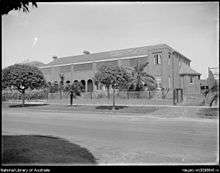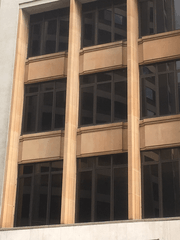Thomas Pollard Sampson
Thomas Pollard Sampson (24 June 1875 – 25 June 1961) was a Tasmanian-born Australian architect active in New South Wales during the first forty years of the 20th century. His work encompassed the styles of the Federation Arts and Crafts and Bungalow through to the Inter-War Styles.[1] In 1912 he designed an octagonal roofed stadium at Rushcutters Bay that seated up to 12,000 spectators. At the time, the Sydney Stadium was considered to be "the largest roofed-in structure in the world."[2]
Thomas Pollard Sampson | |
|---|---|
 Wallis Hall at Meriden School Strathfield designed by T. P. Sampson in 1936 | |
| Born | 24 June 1875 Launceston, Tasmania |
| Died | 25 June 1961 (aged 86) Paddington, New South Wales |
| Other names | T. P. Sampson |
| Education | Launceston High School |
| Occupation | Architect |
| Known for | Architecture |
| Spouse(s) | Clarice Effie Henderson |
| Children | Daughter Phyllis Marjorie Sampson (1911-2011) Son-in-law (1932-1961) Major General Paul Alfred Cullen, AC, CBE, DSO & Bar, ED (1909-2007) |
| Parent(s) | Richard Sampson (c.1847-1917) Caroline Elizabeth née Pollard (1849-1945) |
| Relatives | Senator Burford Sampson cousin |



Family and life
Sampson was born in Launceston, Tasmania, to Richard Sampson (c.1847-1917) and Caroline Elizabeth Pollard (1849-1945). His maternal grandparents were from Yorkshire, England, and his extended family were members of the Methodist Church. He attended the independent school known as Launceston High School that existed from 1884 until 1912. It was founded by Edward Alleyne Nathan who had been a teacher at Launceston Church Grammar School. The school was at Milton Hall in Frederick Street, Launceston, and eventually merged with Launceston Church Grammar School.[3] The alumni of both schools held joint reunions as the Old Launcestonians' Association after the schools merger and Sampson attended these reunions in Sydney.[4] He married Clarice Henderson on 17 February 1911 at St Philip's Church, Sydney and died on 25 Jun 1961 at the Scottish Hospital, Paddington.[5] Sampson and his wife had one daughter, Phyllis (Phyl) Marjorie Sampson, who was born on 8 August 1911 in Sydney. In February 1932, at Woollahra, she married Paul Cohen a son of Sir Samuel and Lady Cohen.[6] The marriage produced twins, Christopher and Dinah Cohen. In 1941, Paul Cohen changed his Jewish name and those of his family to Cullen. He was fighting the Germans in North Africa, Greece and Crete and knew that, were he captured he would not be treated as a Prisoner of War.[7] The marriage ended in divorce in 1961. Phyl Cullen died on 22 October 2011 in Elizabeth Bay, New South Wales, aged 100 years.[8]
Career
He was articled in architecture to A.E. Luttrell of Cameron Street, Launceston[9] In 1891 Sampson exhibited an architectural drawing of a design for a villa residence in the Tasmanian Industrial Exhibition. He had been articled for six months at that time and had become an architectural photographer taking many notable images of Launceston buildings.
Sampson moved to Sydney to practise as an architect. In 1907 he designed an estate of 32 houses in Manly, New South Wales.[10] In 1919 he partnered with Harold Minton Taylor, a solicitor, and purchased 'Rosebank House', Darlinghurst, and adjoining land. They demolished the original house and constructed several apartment blocks, including Upton Court in Forbes Street.
Notable works
- R.C. Henderson Hat Manufactures, wharehouse and office, 11-13 Randle Street Surry Hills (1912)[11]
- Sydney Stadium, Neild Avenue, Rushcutters Bay. (1912, demolished 1970)[12]
- Kama, house, 16 Llandilo Avenue, Strathfield (1913)[13]
- Romahapa, house, 22-24 Martin Road, Centennial Park (1914)[14][15]
- Villa Regina, house, Neutral Bay (1915 demolished c1976)[16]
- House, 11 Kingsland Avenue, Strathfield, New South Wales (1915)[17]
- Former Commonwealth Hotel, 461 Elizabeth Street, Surry Hills (1919, facade only remains)[18]
- Upton Court, 12 residential flats, 186 Forbes Street, Darlinghurst (1919)[19][20]
- Concord Golf Club Clubhouse, Concord (1921)[21]
- Grantchester, 6 residential flats, 420 Edgecliff Road, Edgecliff (1926)[22]
- Pennant Hills Golf Club Clubhouse, Beecroft, New South Wales (1925/1929/1939)[23]
- Western Suburbs Builders' Exchange, 353-355 Liverpool Road Ashfield (1929) [24]
- House, 3 Turuga Street, Turramurra, New South Wales (1933)[25][26]
- Wallis Hall, Meriden School, Strathfield (1936)[27]
- Insurance House, 263 George Street, Sydney (1939, sandstone fenestration only remains)[28]
External link
References
- LINC Thomas Pollard Sampson 22 August 2017.
- "No title". Construction : Weekly Supplement To Building. 11 (233). New South Wales, Australia. 29 July 1912. p. 8. Retrieved 4 June 2019 – via National Library of Australia.
- Launceston High School Retrieved 19 June 2019.
- "Old Launcestonians' Association". The Advocate (Australia). Tasmania, Australia. 25 July 1939. p. 5. Retrieved 19 June 2019 – via National Library of Australia.
- Thomas Pollard Sampson and Family NG2919 [Records], LINC Tasmania, 1875, retrieved 1 March 2019
- "TOPICS FOR WOMEN". The Sun (6971). New South Wales, Australia. 4 May 1932. p. 16 (LAST RACE EDITION). Retrieved 3 March 2019 – via National Library of Australia.
- Paul Alfred Cullen (1909–2007) Retrieved 3 March 2019.
- Phyllis Marjorie (Sampson) Cullen (1911 - 2011) Retrieved 3 March 2019.
- Freeland, J.M. The Making of a Profession, Angus & Robertson, (Sydney, 1971) pp 210
- "BUILDING AND CONSTRUCTION". The Daily Telegraph (8652). New South Wales, Australia. 23 February 1907. p. 14. Retrieved 13 June 2019 – via National Library of Australia.
- 11–13 Randle Street, Surry Hills, Conservation
- "No title". Construction : Weekly Supplement To Building. 11 (233). New South Wales, Australia. 29 July 1912. p. 8. Retrieved 1 June 2019 – via National Library of Australia.
- "Heritage | NSW Environment & Heritage". Heritage.nsw.gov.au. Retrieved 22 August 2017.
- "Heritage | NSW Environment & Heritage". Heritage.nsw.gov.au. Retrieved 22 August 2017.
- Centennial Park – Federation House Retrieved 22 August 2017.
- "No title". Construction And Local Government Journal. XVII (424). New South Wales, Australia. 17 March 1916. p. 12. Retrieved 1 March 2019 – via National Library of Australia.
- "CONTENTS. JUNE. 1916", The Salon : Being the Journal of the Institute of Architects of New South Wales, 6 (5): 2, 1 June 1916, retrieved 7 June 2019
- "Advertising". Construction And Local Government Journal. XXIII (616). New South Wales, Australia. 17 November 1919. p. 20. Retrieved 13 June 2019 – via National Library of Australia.
- "BUILDING-INDUSTRY & MACHINERY". The Sun (2705). New South Wales, Australia. 3 March 1919. p. 7. Retrieved 3 March 2019 – via National Library of Australia.
- "Advertising". The Sydney Morning Herald (25, 655). New South Wales, Australia. 27 March 1920. p. 4. Retrieved 3 March 2019 – via National Library of Australia.
- Concord Golf Course History Retrieved 22 August 2017.
- Grantchester Retrieved 11 December 2019.
- "MODERN LIGHT FITTINGS AT PENNANT HILLS GOLF CLUB HOUSE", Decoration and Glass, 5 (2): 54, 1 July 1939, retrieved 1 March 2019
- "No title". Construction and Local Government Journal. NSW: National Library of Australia. 29 May 1929. p. 14. Retrieved 22 August 2017.
- Ku-ring-gai Historical Society (1972), The Historian, Ku-ring-gai Historical Society, ISSN 0310-298X
- "SATISFACTORY OUTLOOK". The Sydney Morning Herald (29, 821). New South Wales, Australia. 1 August 1933. p. 5. Retrieved 9 June 2019 – via National Library of Australia.
- "ADDITIONS TO SCHOOL". The Sydney Morning Herald. National Library of Australia. 10 December 1935. p. 6. Retrieved 22 August 2017.
- "Two Interesting Sydney Remodelling Projects CONTRAST AND COMPARISON", Building : The Magazine for the Architect, Builder, Property Owner and Merchant, 65 (385): 30, 25 September 1939, retrieved 3 March 2019